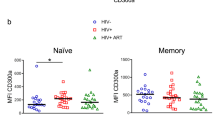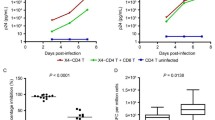Abstract
CD4+ T-helper cells appear to be essential in sustaining immune responses in chronic viral infections, as the maintenance of CD8+ cytotoxic T-lymphocyte responses and the control of viremia were demonstrated to depend on CD4+ T cell help. In order to investigate the function of HIV-specific CD4+ T cells in chronic HIV-1-infection, 49 chronically HIV-infected patients were analyzed before and 3 and 6 months after initiation of antiviral treatment. Ten patients showed a substantial, although weak, proliferative response to HIV-1-p55gag protein for which no improvement was observed upon initiation of HAART. From one individual, HIV-1-p55gag-specific CD4-positive T-cell clones were generated that were heterogeneous in their TCR Vβ gene usage and HLA-DRB1*13 and DRB1*03 restricted, respectively. In addition, some CD4+ TCC produced substantial amounts of IFN-γ and MIP-1α/β, were perforin-positive, and showed cytotoxic activity. These diverse functional features of HIV-specific CD4+ T cells suggest that they may exert direct antiviral activity.
Similar content being viewed by others
REFERENCES
Shearer GM: HIV-induced immunopathogenesis. Immunity 9:587–593, 1998
Hammer SM, Squires KE, Hughes MD, Grimes JM, Demeter LM, Currier JS, Eron JJ, Jr, Feinberg JE, Balfour HH, Jr, Deyton LR, Chodakewitz JA, Fischl MA: A controlled trial of two nucleoside analogues plus indinavir in persons with human immunodeficiency virus infection and CD4 cell counts of 200 per cubic millimeter or less. AIDS Clinical Trials Group 320 Study Team. N Engl J Med 337:725–733, 1997
Gulick RM, Mellors JW, Havlir D, Eron JJ, Gonzalez C, McMahon D, Richman DD, Valentine FT, Jonas L, Meibohm A, Emini EA, Chodakewitz JA: Treatment with indinavir, zidovudine, and lamivudine in adults with human immunodeficiency virus infection and prior antiretroviral therapy. N Engl J Med 337:734–739, 1997
Collier AC, Coombs RW, Schoenfeld DA, Bassett RL, Timpone J, Baruch A, Jones M, Facey K, Whitacre C, McAuliffe VJ, Friedman HM, Merigan TC, Reichman RC, Hooper C, Corey L: Treatment of human immunodeficiency virus infection with saquinavir, zidovudine, and zalcitabine. N Engl J Med 334:1011–1017, 1996
Autran B, Carcelain G, Li TS, Blanc C, Mathez D, Tubiana R, Katlama C, Debre P, Leibowitch J: Positive effects of combined antiretroviral therapy on CD4+ T cell homeostasis and function in advanced HIV disease. Science 277:112–116, 1997
Wendland T, Furrer HJ, Vernazza PL, Frutig K, Christen A, Matter L, Malinverni R, Pichler WJ: HAART in HIV-infected patients: Restoration of antigen-specific CD4 T cell responses in vitro is correlated with CD4 memory T-cell reconstitution, but DTH improvement to decrease of viraemia. AIDS 13:1857–1862, 1999
Li TS, Tubiana R, Katlama C, Calvez V, Ait Mohand H, Autran B: Long-lasting recovery in CD4 T-cell function and viral-load reduction after highly active antiretroviral therapy in advanced HIV-1 disease. Lancet 351:1682–1686, 1998
Pitcher CJ, Quittner C, Peterson DM, Connors M, Koup RA, Maino VC, Picker LJ: HIV-1-specific CD4+ T cells are detectable in most individuals with active HIV-1 infection, but decline with prolonged viral suppression. Nat Med 5:518–525, 1999
Rosenberg ES, Altfeld M, Poon SH, Phillips MN, Wilkes BM, Eldridge RL, Robbins GK, D'Aquila RT, Goulder PJ, Walker BD: Immune control of HIV-1 after early treatment of acute infection. Nature 407:523–526, 2000
Rosenberg ES, Billingsley JM, Caliendo AM, Boswell SL, Sax PE, Kalams SA, Walker BD: Vigorous HIV-1-specific CD4+ T cell responses associated with control of viremia Science 278:1447–1450, 1997
Zajac AJ, Blattman JN, Murali-Krishna K, Sourdive DJ, Suresh M, Altman JD, Ahmed R: Viral immune evasion due to persistence of activated T cells without effector function J Exp Med 188:2205–2213, 1998
Maloy KJ, Burkhart C, Freer G, Rulicke T, Pircher H, Kono DH, Theofilopoulos AN, Ludewig B, Hoffmann-Rohrer U, Zinkernagel RM, Hengartner H: Qualitative and quantitative requirements for CD4+ T cell-mediated antiviral protection. J Immunol 162:2867–2874, 1999
Battegay M, Moskophidis D, Rahemtulla A, Hengartner H, Mak TW, Zinkernagel RM: Enhanced establishment of a virus carrier state in adult CD4+ T-cell-deficient mice. J Virol 68:4700–4704, 1994
Matloubian M, Concepcion RJ, Ahmed R: CD4+T cells are required to sustain CD8+ cytotoxic T-cell responses during chronic viral infection. J Virol 68:8056–8063, 1994
von Herrath MG, Yokoyama M, Dockter J, Oldstone MB, Whitton JL: CD4-deficient mice have reduced levels of memory cytotoxic T lymphocytes after immunization and show diminished resistance to subsequent virus challenge. J Virol 70:1072–1079, 1996
Cardin RD, Brooks JW, Sarawar SR, Doherty PC: Progressive loss of CD8+ T cell-mediated control of a gamma-herpesvirus in the absence of CD4+ T cells. J Exp Med 184:863–871, 1996
Siliciano RF, Lawton T, Knall C, Karr RW, Berman P, Gregory T, Reinherz EL: Analysis of host–virus interactions in AIDS with anti-gp120 T cell clones: Effect of HIV sequence variation and a mechanism for CD4+ cell depletion. Cell 54:561–575, 1988
Orentas RJ, Hildreth JE, Obah E, Polydefkis M, Smith GE, Clements ML, Siliciano RF: Induction of CD4+ human cytolytic T cells specific for HIV-infected cells by a gp160 subunit vaccine. Science 248:1234–1237, 1990
Erb P, Grogg D, Troxler M, Kennedy M, Fluri M: CD4+ T cell-mediated killing of MHC class II-positive antigen-presenting cells. Characterization of target cell recognition by in vivo or in vitro activated CD4+ killer T cells. J Immunol 144:790–795, 1990
Hahn S, Erb P: The immunomodulatory role of CD4-positive cytotoxic T-lymphocytes in health and disease. Int Rev Immunol 18:449–464, 1999
Ottenhoff TH, Mutis T: Specific killing of cytotoxic T cells and antigen-presenting cells by CD4+ cytotoxic T cell clones. A novel potentially immunoregulatory T-T cell interaction in man. J Exp Med 171:2011–2024, 1990
Stalder T, Hahn S, Erb P: Fas antigen is the major target molecule for CD4+ T cell-mediated cytotoxicity. J Immunol 152:1127–1133, 1994
Susskind B, Shornick MD, Iannotti MR, Duffy B, Mehrotra PT, Siegel JP, Mohanakumar T: Cytolytic effector mechanisms of human CD4+ cytotoxic T lymphocytes. Hum Immunol 45:64–75, 1996
Mauri D, Wyss-Coray T, Gallati H, Pichler WJ: Antigenpresenting T cells induce the development of cytotoxic CD4+ T cells. I.Involvement of the CD80-Cd28 adhesion molecules. J Immunol 155:118–127, 1995
Schnyder B, Mauri-Hellweg D, Zanni M, Bettens F, Pichler WJ: Direct, MHC-dependent presentation of the drug sulfamethoxazole to human alphabeta T cell clones. J Clin Investig 100:136–141, 1997
Yasukawa M, Ohminami H, Yakushijin Y, Arai J, Hasegawa A, Ishida Y, Fujita S: Fas-independent cytotoxicity mediated by human CD4+ CTL directed against herpes simplex virus-infected cells. J Immunol 162:6100–6106, 1999
Norris PJ, Sumaroka M, Brander C, Moffett HF, Boswell SL, Nguyen T, Sykulev Y, Walker BD, Rosenberg ES: Multiple effector functions mediated by human immunodeficiency virusspecific CD4(+) T-cell clones. J Virol 75:9771–9779, 2001
Wagner R DL, Fliessbach H, Wanner G, Wolf H: Assembly and extracellular release of chimeric HIV-1 pr55gag retrovirus-like particles. Virology 200:162–175, 1994
Korber B, Walker BD, Brander C, Koup R, Moore J, Haynes B, Meyers G. The HIV Molecular Immunology Database 1996. Los Alamos National Laboratory: Theoretical Biology and Biophysics, Los Alamos, NM, 1996
Kataoka T, Shinohara N, Takayama H, Takaku K, Kondo S, Yonehara S, Nagai K: Concanamycin A, a powerful tool for characterization and estimation of contribution of perforin-and Fas-based lytic pathways in cell-mediated cytotoxicity. J Immunol 156:3678–3686, 1996
Nylander S, Kalies I: BFA but not monensin, completely blocks CD69 expression on mouse lymphocytes: Efficacy of inhibitors of protein secretion in protocols for ICS by flow cytometry. J Immunol Methods 224:69–76, 1999
Yawalkar N, Egli F, Hari Y, Nievergelt H, Braathen LR, Pichler WJ: Infiltration of CTL in drug-induced cutaneous eruptions. Clin Exp Allergy 30:847–855, 2000
Padovan E CG, Dellabona P, Meyer S, Brockhaus M, Lanzavecchia A: Expression of two T cell receptor alpha chains: Dual receptor T cells. Science 262:422–424, 1993
Kalams SA, Walker BD: The critical need for CD4 help in maintaining effective cytotoxic T lymphocyte responses. J Exp Med 188:2199–2204, 1998
LaSalle JM, Tolentino PJ, Freeman GJ, Nadler LM, Hafler DA: Early signaling defects in human T cells anergized by T cell presentation of autoantigen. J Exp Med 176:177–186, 1992
Pichler WJ, Wyss-Coray T: T cells as antigen-presenting cells. Immunol Today 15:3350–3357, 1994
Rosenberg ES, Walker BD: HIV type 1-specific helper T cells: A critical host defense. Aids Res Hum Retroviruses 14 Suppl 2:S143–147, 1998
Kalams SA, Buchbinder SP, Rosenberg ES, Billingsley JM, Colbert DS, Jones NG, Shea AK, Trocha AK, Walker BD: Association between virus-specific cytotoxic T-lymphocyte and helper responses in human immunodeficiency virus type 1 infection. J Virol 73:6715–6720, 1999
Deng H, Liu R, Ellmeier W, Choe S, Unutmaz D, Burkhart M, Di Marzio P, Marmon S, Sutton RE, Hill CM, Davis CB, Peiper SC, Schall TJ, Littman DR, Landau NR: Identification of a major co-receptor for primary isolates of HIV-1. Nature 381:661–666, 1996
Dragic T, Litwin V, Allaway GP, Martin SR, Huang Y, Nagashima KA, Cayanan C, Maddon PJ, Koup RA, Moore JP, Paxton WA: HIV-1 entry into CD4+ cells is mediated by the chemokine receptor CC-CKR-5. Nature 381:667–673, 1996
Alkhatib G, Combadiere C, Broder CC, Feng Y, Kennedy PE, Murphy PM, Berger EA: CC CKR5: A RANTES, MIP-1 alpha, MIP-1 beta receptor as a fusion cofactor for macrophage-tropic HIV-1. Science 272:1955–1958, 1996
Feng Y, Broder CC, Kennedy PE, Berger EA: HIV-1 entry cofactor: Functional cDNA cloning of a seven-TM, G-proteincoupled receptor. Science 272:872–877, 1996
Triozzi PL, Bresler HS, Aldrich WA: HIV type 1-reactive chemokine-producing CD8+ and CD4+ cells expanded from infected lymph nodes. Aids Research-Human Retroviruses 14:643–649, 1998
Weiss RA, Clapham PR: Hot fusion of HIV. Nature 381:647–648, 1996
Littman DR: Chemokine receptors: keys to AIDS pathogenesis? Cell 93:677–680, 1998
Schnyder B, Frutig K, Mauri-Hellweg D, Limat A, Yawalkar N, Pichler WJ: T-cell-mediated cytotoxicity against keratinocytes in sulfamethoxazol-induced skin reaction. Clin Exp Allergy 28:1412–1417, 1998
Brander C, Matter-Reissmann U, Jones NG, Walker BD, Sachs DH, Seebach J. Inhibition of human NK cell-mediated cytotoxicity by exposure to ammonium chloride. J Immunol Methods 252:1–14, 2001
Author information
Authors and Affiliations
Rights and permissions
About this article
Cite this article
Lotti, B., Wendland, T., Furrer, H. et al. Cytotoxic HIV-1 p55gag-Specific CD4+ T Cells Produce HIV-Inhibitory Cytokines and Chemokines. J Clin Immunol 22, 253–262 (2002). https://doi.org/10.1023/A:1020066404226
Issue Date:
DOI: https://doi.org/10.1023/A:1020066404226




